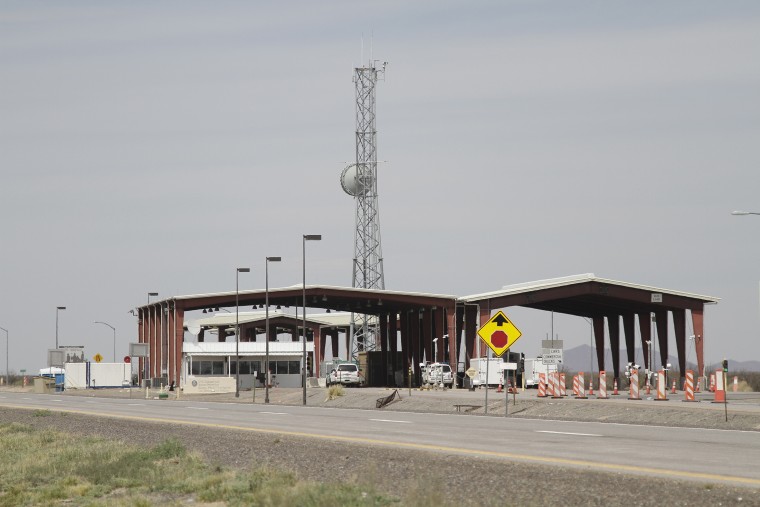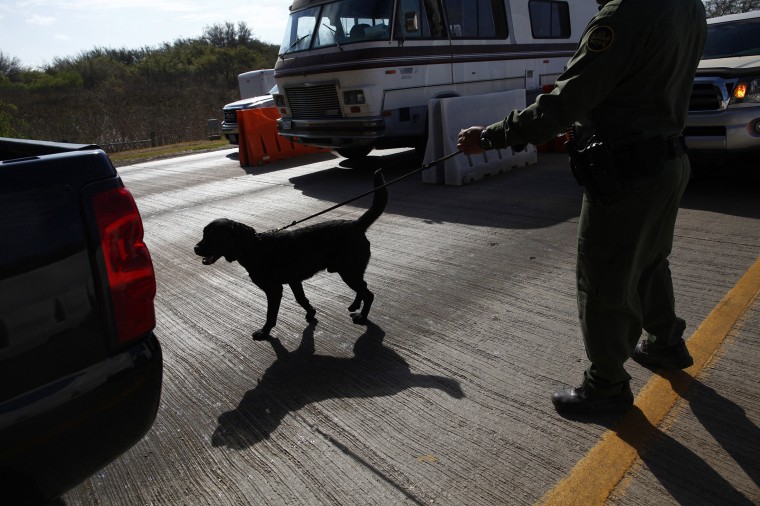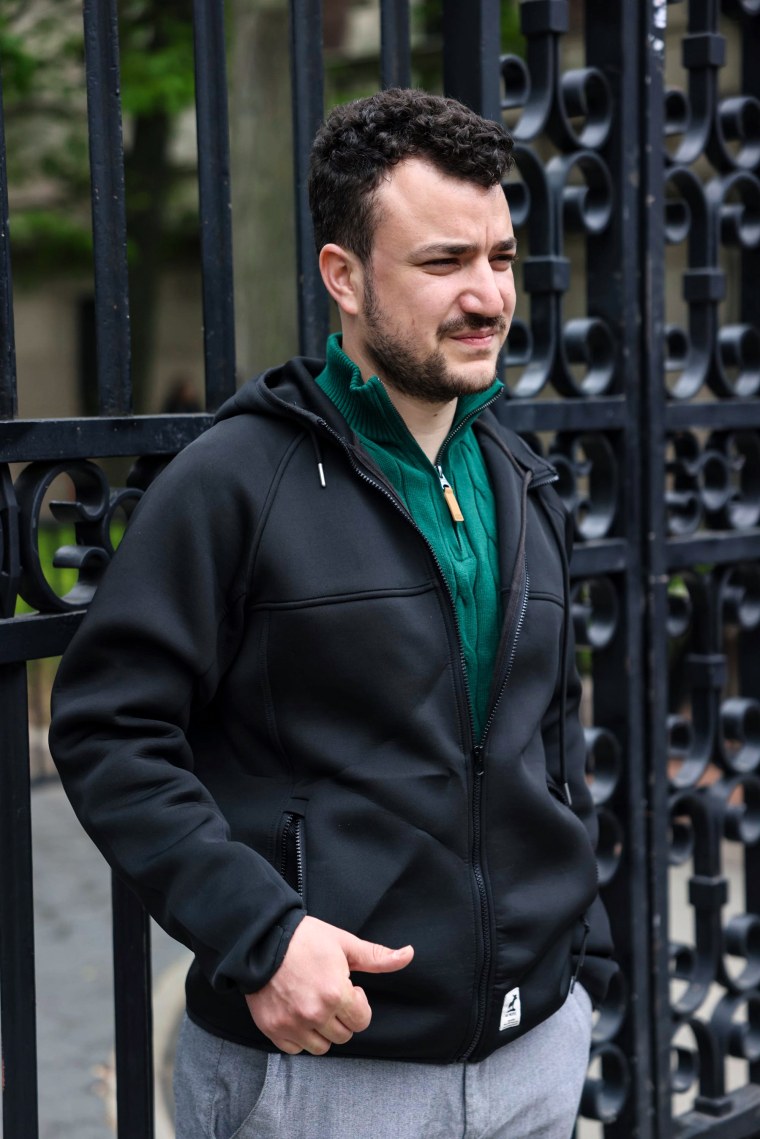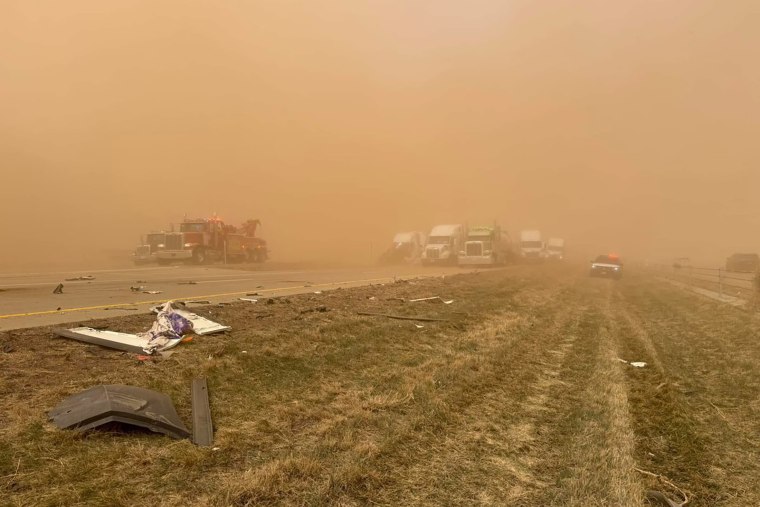Americas
Immigration checkpoints are a way of life in areas within 100 miles from U.S. borders

Well before President Donald Trump’s immigration crackdown further opened the door for agents and officers to question people about their citizenship and legal status, the Border Patrol had been doing exactly that at checkpoints flanking roadways within the United States.
It was at such an inland checkpoint that on Feb. 4 Border Patrol apprehended the parents of five children, four of them U.S. citizens.
They were en route from Rio Grande City, Texas, to Houston for emergency medical care for their 10-year-old daughter who has brain cancer, NBC News reported, when they arrived at the Falfurrias checkpoint. Rio Grande City is about 360 miles southwest of Houston, and about an 85-mile to 104-mile drive from the checkpoint, depending on the route taken.
The parents, who did not have documentation showing they were citizens or had legal status, were deported. Seeing no other options, they took their five children with them to Mexico, uncertain how they’d get their daughter the care she needs.
Located up to 100 miles from the U.S. borders with Mexico and Canada, Border Patrol checkpoints have long dotted U.S. arteries, serving as something of a secondary border — or tertiary when considering areas where border wall and fencing has been built.
In a 1976 decision, the Supreme Court ruled 7-2 that the Border Patrol’s routine stops and brief questioning at checkpoints that are “a reasonable distance from the border” do not violate Fourth Amendment protections against search and seizure.
The federal government has defined reasonable distance as within 100 air miles (about 115 miles) or shorter distance, as set by the Customs and Border Protection chief or Immigration and Customs Enforcement special agent for a specific sector or district. That 100 air-mile limit creates a boundary that covers every U.S. land border or water boundary.
The up to 100 miles from the nation’s land and water boundaries takes in all of Florida and a number of major cities, including Los Angeles, Seattle, Boston, New York and Houston.
Not everyone in those cities passes through checkpoints unless they travel to the land borders or live behind them.
But for a large swath of the U.S. population, checkpoints are a regular part of life, where they must affirm — some more than others because of race — that they are citizens or have legal residency in the U.S. and they aren’t shuttling contraband or human cargo deeper into the country.
In Texas’ Rio Grande Valley, two permanent checkpoints are in Sarita on Highway 69-East and another at Falfurrias, on U.S. Highway 281, where Border Patrol agents stopped the young girl with brain cancer and her family. Both lie between Rio Grande City, on the border, and Houston.
“Anywhere you go north, you will find a checkpoint” in the Rio Grande Valley said Felix Rivera, a social worker with La Union del Pueblo Entero, LUPE, a community advocacy organization founded by civil rights leaders Cesar Chavez and Dolores Huerta.
“People that are here undocumented, they are like in a cage. If they go to San Antonio, they will find the checkpoint at Falfurrias, if they go to other areas of the state, they will find other checkpoints, so it’s very hard for an undocumented person to get out,” Rivera told NBC News. There are no checkpoints for traffic heading south.
Many U.S. citizens drive through them regularly with little problem.
Typically, the process goes like this: Vehicles are detoured into the checkpoint from the highway, queuing up if there is a line. Each vehicle then pulls up to the Border Patrol agent on duty, drivers roll down the window, pronounce their citizenship or respond to a question of whether they are citizens, and move on. Driver’s licenses or proof of presence aren’t always requested, but can be when people are pulled out of line and sent to another area for “secondary inspection.”

There are 34 permanent checkpoints on the southwest border and one on the northern land border. An estimated 50 million vehicles pass through the checkpoints daily, CBP said.
The agency said in an email that it does not provide a public map of the checkpoint locations and declined to provide a total number of apprehensions or seizures at checkpoints, saying the information was law-enforcement sensitive.
When vehicles pass through a checkpoint, “if an agent has suspicion that the occupants of the vehicle are present in the United States illegally, or there is reasonable suspicion that another federal crime has been committed, the vehicle and all occupants will be referred for a more in-depth secondary inspection,” CBP stated.
In a 2022 report, the Government Accountability Office, citing CBP data, stated Border Patrol arrested about 35,700 people who could potentially be removed from the U.S. in about 17,500 “events” at checkpoints, during the fiscal years 2016 through 2020. At that time, CBP data on apprehensions of people was unreliable, the GAO said, despite the creation of a Checkpoint Program Management Office in 2013 to oversee the checkpoints.
The checkpoints aren’t always operating. In 2019, some Border Patrol checkpoints were shut down and their personnel shifted to helping process asylum-seekers who were arriving in higher numbers at the border.
The family that was stopped at the Falfurrias checkpoint had passed a few other times through the checkpoint without incident, carrying letters from doctors and lawyers regarding their plans for the trip to seek medical care.
Rivera said LUPE has several members that have children that needed “to go up north” for surgery. Working with their attorneys, LUPE created a letter directed to the Border Patrol that would allow them to travel in that direction, stating “that it was a humanitarian matter.”
“And sometimes those letters do not work, they end up in deportation proceedings,” Rivera said. “It depends on how the officer looks at you, and sometimes they are kind of racist.” He said LUPE always warns families that the letters may not protect them.
Making trips to larger cities is critical for those in the Rio Grande Valley, which has long struggled with health care access. While there have been improvements, the limited availability of affordable health care is particularly problematic given the area’s large uninsured population and higher incidence of certain diseases such as diabetes. That forces families to travel to larger urban areas beyond the checkpoints for care.

Rivera said he was shocked when he moved from Los Angeles to the Rio Grande Valley and encountered the checkpoints, even though he said he has never had an issue passing through one.
In February, a warning from a South Texas school district that agents at checkpoints might board school buses carrying schoolchildren to extracurricular activities panicked parents in the region.
But U.S. Border Patrol Chief Mike Banks called the warning “absurd,” leading the school district to remove the warning from public online sites. The Texas Tribune reported that even as CBP said it does not target school buses, it repeated in an email that is has the authority to verify immigration status of any passengers on buses that pass through checkpoints, including students.
Americas
Nationwide protests planned after arrest of former Columbia University activist by immigration authorities

Nationwide protests are planned this weekend after Mahmoud Khalil, a former Columbia University student activist, was arrested by immigration authorities, fueling tensions between the Trump administration and student movements over immigration policy.
Khalil, 30, was taken into custody by Immigration and Customs Enforcement agents in the middle of the night last weekend, prompting outrage in recent days. Khalil, an Algerian citizen of Palestinian descent, helped lead pro-Palestinian demonstrations at Columbia University last spring.
Protests calling for his release will be held in cities including New York City, Boston, Phoenix, Charlotte, Oklahoma City, Miami and Indianapolis on Saturday and Sunday.
Several dozen protestors gathered in Times Square on Saturday afternoon, wearing traditional Palestinian scarfs, known as kuffiyehs, and waving Palestinian flags.
“Release Mahmoud right now!” the protestors shouted.
Grant Miner, the former president of a union representing thousands of Columbia student workers who were fired and expelled this week, addressed the crowd. He described Mahmoud’s detention as “a campaign of fear.”
“We must stand up together to tell Trump and his billionaire buddies that we’re not going to stand for this intimidation and the backsliding of civil rights in this country,” he said.
To justify Khalil’s arrest, the Trump administration cited an obscure foreign-policy clause that allows the federal government to deport foreign nationals whom it deems national security threats. The Department of Homeland Security alleges that Khalil “led activities aligned to Hamas, a designated terrorist organization.”

On Monday, a federal judge temporarily blocked the Trump administration from expelling Khalil, a legal permanent resident, from the country as he challenges his deportation.
Khalil filed an amended petition and complaint in federal district court in Manhattan on Thursday, stating he was the target of “retaliatory detention and attempted removal of a student protestor because of his constitutionally protected speech.” Khalil finished his classes at Columbia in December 2024 and was expected to graduate in the spring, according to the filing.
Immigration authorities are holding the 30-year-old in Louisiana and his lawyers have petitioned for him to be returned to New York City. His wife, an American, is eight months pregnant.
“I urge you to see Mahmoud through my eyes as a loving husband and the future father to our baby,” she said in a statement through Khalil’s defense counsel on Monday. “I need your help to bring Mahmoud home, so he is here beside me, holding my hand in the delivery room as we welcome our first child into this world.”
Trump administration targets campus protesters
Khalil’s arrest marks the first attempt to fulfill President Donald Trump’s campaign pledge to deport international students who protested in support of Palestinians on campuses across the country last spring.
On Tuesday, a doctoral student from India whom DHS accused of supporting Hamas self-deported to Canada. And on Friday, another Palestinian student who took part in Columbia’s protests last year, identified by DHS as Leqaa Kordia, was arrested for allegedly overstaying her student visa.
“It is a privilege to be granted a visa to live and study in the United States of America,” DHS Secretary Kristi Noem said in a statement on Friday. “When you advocate for violence and terrorism that privilege should be revoked, and you should not be in this country.”
DHS agents also raided two Columbia dormitories on Thursday evening, but made no arrests, according to a statement by the university. Commenting on the raids on Friday, Deputy Attorney General Todd Blanche said the Justice Department was “looking at whether Columbia’s handling of earlier incidents violated civil rights laws and included terrorism crimes.”
Civil rights groups and protesters have denounced the federal government’s actions at Columbia as an infringement on free speech. Protesters staged demonstrations this week at both the university and inside Trump Tower, located in Manhattan.
Columbia’s international students have expressed fear, with several telling NBC News on Friday that they are increasingly hesitant to criticize the Trump administration due to fears of repercussions.
The university’s journalism school said its staff and students are “witnessing and experiencing an alarming chill.”
“One does not have to agree with the political opinions of any particular individual to understand that these threats cut to the core of what it means to live in a pluralistic democracy,” the journalism school said in a statement issued Friday. “The use of deportation to suppress foreign critics runs parallel to an aggressive campaign to use libel laws in novel — even outlandish ways — to silence or intimidate the independent press.”
Columbia University in the glaring spotlight
The arrests are part of the Trump administration’s broader effort to “root out” what it calls “anti-Semitic harassment in schools and on college campuses.” And perhaps no other college campus in the country drew more attention for its pro-Palestinian demonstrations last year than Columbia.
For weeks last spring, student activists staged daily protests, occupied a university building and established an encampment of several dozen tents on university lawns, inspiring similar setups on college campuses across the country. Fueled by outrage over Israel’s war in Gaza, students pushed for their universities to divest from companies linked to the Israeli government. The activism sparked intense debates on campuses, with some students expressing concerns over antisemitism.
In the week before the arrests, the Trump administration singled out Columbia, announcing that it would cancel approximately $400 million in federal grants to the university. The administration cited “the school’s continued inaction in the face of persistent harassment of Jewish students.”
The move marked an unprecedented intervention by the federal government into the affairs of a private university.
Columbia responded by pledging to work with the federal government to restore its funding.
“We take Columbia’s legal obligations seriously and understand how serious this announcement is and are committed to combatting antisemitism and ensuring the safety and wellbeing of our students, faculty, and staff,” a university spokesperson told NBC News last week.
On Thursday, the university said it suspended or expelled some of the students who participated and temporarily revoked the diplomas of some graduates.
“I’m not surprised that the university is choosing to throw its students and workers under the bus for grant money,” Miner told NBC News. “We know exactly how much now it costs, to buy Columbia’s morals.”
Americas
One of Jackie and Shadow’s baby eaglets has vanished from Big Bear nest cam

Jackie and Shadow, the Big Bear bald eagle couple whose parenting journey has been livestreamed to the world, appear to be missing one of the three eaglets that hatched this season.
Video of the nest posted to social media Thursday afternoon showed three baby birds in the nest being fed by their parents.
But as of Friday, only two eaglets appeared to be in Jackie and Shadow’s nest, according to the Big Bear Bald Eagle Live Nest Cam.
It’s not clear what happened to the third eaglet, but Friends of Big Bear Valley said late on Friday that it was possible the remains of the missing chick may have been observed in the nest bowl.
“We are waiting for more clear visuals to confirm,” read the statement,” adding that the view into the nest bowl is partially obstructed by snow.
“We know that both the possibility and the uncertainty are hard to hear,” the organization said in an update. “We share these feelings with all of you.”
At daybreak on Saturday, an eagle could be seen feeding just two eaglets a dead frog.
Jackie laid three eggs at the end of January, according to Big Bear, and all three hatched last week.
The first hatched March 3, the second on March 4, and the third a few days later.
It is unclear which of the three birds is missing.
Americas
At least six dead as threat of tornadoes moves south and blinding winds fan wildfires

At least three people have died as a powerful system of storms sweeps across the a wide swathe of the central and southern of the United States, with another three killed in vehicle crashes as blinding winds whipped through Texas and Oklahoma.
From the southern Plains to the Midwest an estimated 138 million people are at risk of severe weather, with tornado warnings issued in parts of Illinois, Missouri, Arkansas, Mississippi, Indiana, Kentucky, Louisiana and Tennessee.
The storm system has left buildings in ruins, wrecked power supplies, and intensified more than 100 wildfires.
The Missouri State Highway Patrol said on X that a tornado had caused two deaths in the Bakersfield area in Ozark County, with reports of multiple injuries. It posted pictures of wrecked and ruined buildings, and a smashed up car on the roadside.
Another person died in Butler County, on Missouri’s border with Arkansas, after a mobile home was hit by extreme weather on Friday night, the county’s rescue services told NBC News.
Butler County Emergency Management said the number of fatalities there may rise, with the search and rescue operations at the site ongoing.
In the Texas Panhandle, three people were killed by car crashes caused by a a dust storm on Friday, according to Texas Department of Public Safety Sgt. Cindy Barkley. She said that the crashes were in the Amarillo area, and blamed high winds and low visibility.
Millions remain at risk as the storm carves a path through the region.
More than 300,000 customers are without power across the Midwest and South, according to PowerOutage.us, an organization that aggregates live power outage data.
Nearly half a dozen tornadoes were reported in Missouri alone.
Tornadoes were reported to have ripped down trees and power lines in the state, according to the National Weather Service, and NBC affiliate KSDK of St. Louis reported that businesses were damaged and tractor-trailers were overturned.
Tornadoes were also reported in Arkansas and Mississippi. The reports are unconfirmed; storm survey teams typically determine later whether tornadoes actually occurred. The weather service for Jackson, Mississippi, shared a photo on X of what was said to be a large wedge tornado north of Cruger.
Footage circulating on social media and verified by NBC News showed the mangled remains of a fuel station outside a 10Box store in Poplar Bluff, Missouri.
Other photos posted by the Missouri Highway Patrol showed storm damage in Rolla, Missouri, around 95 miles southwest of St. Louis, and to a bus barn in Dixon.
Strong nighttime tornadoes at EF2 on the tornado strength scale, defined by sustained winds of 113 to 157 mph, are possible from southern Iowa to Jackson, Mississippi.
The worst of the system is also threatening damaging winds and hail into Saturday. Hail the size of baseballs was reported in Christian County, Missouri, on Friday night, the weather service said.
Widespread tornado, severe weather risk
Missouri Gov. Mike Kehoe declared a state of emergency on Friday as the state prepared for the front’s unstable air overnight. The declaration will allow state resources to reach local governments quicker, his office said.
“I urge all Missourians to stay alert, monitor weather forecasts, and follow official warnings,” he said.
Florissant, Missouri, Mayor Timothy Lowery told KSDK that “we’ve got a lot of damage” in the city, including to many houses. A tree also fell on landmark restaurant Hendel’s, the station reported.
“So, tonight’s been, I’ll say a very horrible night here in the city of Florissant,” Lowery said.
Police in St. Louis warned late Friday that there were reports of vehicles getting trapped in high water, and urged people to “Turn around don’t drown!”
Tornado watches were issued for parts of Indiana, Kentucky, Louisiana, Mississippi, Missouri and Tennessee until at least 3 a.m. CT, with some watches extended until 5 a.m.
A tornado outbreak across the central Gulf Coast states into the Tennessee Valley was also likely late Saturday. Significant tornadoes were possible in eastern Louisiana, in Mississippi, and in Alabama.
Strong winds and fires in Texas, Oklahoma
In Texas, blowing dust blinded drivers with deadly consequences, officials said.
Texas Department of Public Safety Sgt. Cindy Barkley said Friday that there were three fatal crashes in the Amarillo area due to high winds and low visibility. The number of deaths was not immediately clear.
One person died and two others were injured in a crash between three semis and four other vehicles in Palmer County, said Cesar Marquez, city manager and fire chief in Bovina. It was not clear if the crash was included in the three in the Amarillo area.
There was “so much blowing dirt we were getting shocked every time we got near something,” Marquez said.
Parts of northern Texas saw gusts as strong as 62 mph, according to National Weather Service data.
Potter County Fire-Rescue reported four roads were restricted or closed after separate incidents in which big-rigs had “flipped.” The county in the Texas Panhandle includes the northern half of Amarillo.
“Visibility is poor at best and zero in places,” the agency said on social media. “If you don’t have to be out, please stay where you are.”
The dust was not the only concern. The same system whipped up wildfires in Texas and Oklahoma on Friday as the low pressure system moved east.

The largest of the state’s six active wildfires, the Windmill Fire in Roberts County, grew from 500 to 18,000 acres in less than a day, according to Texas A&M Forest Service. The blaze was 50% contained Friday night.
The Rest Area Fire in Gray County marched across 4,500 acres on Friday, but its expansion stopped by early evening, Texas A&M Forest Service said. Firefighters had achieved 30% containment by the end of the day, it said.
Texas A&M Forest Service said on Thursday conditions may be right for a Southern Great Plains Wildfire Outbreak, a dangerous weather formula based in part on low humidity and gusty wind, though such an outbreak was not officially declared by Friday afternoon.
Multiple fires were burning in Oklahoma on Friday night.
Gov. Kevin Stitt urged residents covered by mandatory evacuations in Mannford, a city in the northeastern portion of the state were wildfire raged Friday night, to “leave now.”
Mandatory evacuations were also in effect for parts of Norman, where multiple wildfires were burning, according to the Norman Police Department.
Mandatory evacuations in the city of Stillwater were expanding late Friday, with locations including a Walmart and multiple hotels, and cover “several square miles.”
The winds have apparently also helped fuel multiple structure fires in the city, and firefighting reinforcements are en route, it said in a statement.
The National Weather Service office in Norman said earlier that “a dangerous wildfire outbreak” was underway, later identifying blazes near Chickasha, Chandler, Camargo and Leedey; and near Lake Carl Blackwell, where residents were urged to evacuate. There was also one in Lincoln County, where evacuations were ordered north of the town of Meridian.
Weather system to shift east
The low pressure system is affecting the southern and northern reaches of the nation’s midsection as it pushes eastward, promising upheaval into the eastern U.S. through the end of the weekend.
As it moves into the Eastern Seaboard on Sunday, the tornado threat will shift to Virginia and Carolinas.
On the northern side of the front, including the upper Midwest and the northern Plains, blizzard conditions were forecast for the weekend, with 8 inches of snow possible in some regions.
The new week was expected to bring even more winter storm action when at least two more low pressure systems march eastward, the National Weather Service Weather Prediction Center said.
The first of the two would likely form a solid, counterclockwise winter storm, a process the weather service calls cyclogenesis, it said. It will likely bring snow to the interior, including the Midwest and Great Lakes, with a second storm likely to bring a fresh wave of snow, rain and thunderstorms to a stretch of the nation from the Rocky Mountains to the Upper Midwest mid- to late-week ahead of the first day of astronomical spring on Thursday.
-

 Africa4 days ago
Africa4 days agoSurvivor of Liverpool car ramming talks of shock and panic
-

 Sports3 days ago
Sports3 days agoThe Knicks are bringing hope and title dreams back to New York after years in the doldrums
-

 Lifestyle4 days ago
Lifestyle4 days agoHow to decorate a patio, balcony or other small outdoor space
-

 Lifestyle3 days ago
Lifestyle3 days agoChildren and careers: Talking to kids about what they want to be when they grow up
-

 Asia5 days ago
Asia5 days agoHuge blast rocks Chinese chemical plant, authorities launch rescue operation
-

 Lifestyle3 days ago
Lifestyle3 days agoFaizan Zaki hopes to go from spelling bee runner-up to champ
-

 Middle East5 days ago
Middle East5 days agoThe Take: Why the US and Israel are pushing to privatize aid to Gaza | Israel-Palestine conflict News
-

 Middle East4 days ago
Middle East4 days agoHajj pilgrimage in Saudi Arabia to begin on June 4 | Religion News




